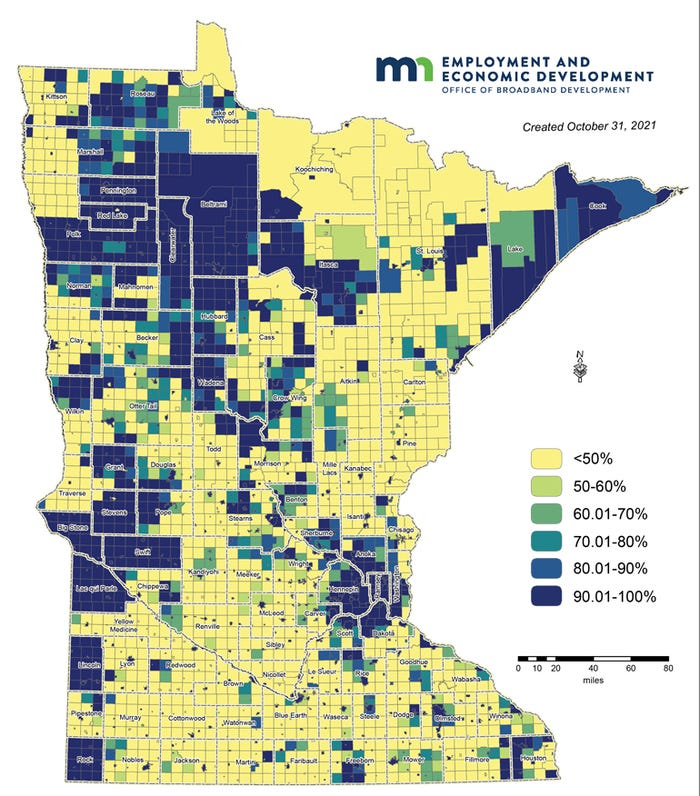
Lack of high-speed internet access continues to be a challenge for some rural areas of Minnesota.
The pandemic brought to light various internet inequities. Most common were reported instances of parents driving their children and the children’s laptops to town so they could connect wirelessly via local businesses to join remotely taught classes. Accordingly, health care visits via telemedicine were available only to those who could connect remotely.
At a Feb. 2 Minnesota House Industrial Education and Economic Development Finance and Policy committee meeting, committee members received a broadband update from Angie Dickison, executive director of the state’s Office of Broadband Development in the Department of Employment and Economic Development (DEED).
She shared the following:
Of households statewide, 88.5% have access to high-speed broadband internet service. High speed is defined as at least 100 megabits per second (Mbps) download and 20 Mbps upload speeds.
Of households in greater Minnesota 75% have similar access. The remaining 25%, roughly 224,000 households outstate, do not.

Extending broadband service to these households is challenging, Dickison said, because they are in sparsely populated areas that require intensive infrastructure development and have associated high labor costs.
Dickison estimated it would cost more than $1.3 billion to achieve complete statewide broadband coverage.
Funding broadband expansion
In her report, Dickison reviewed funding for broadband. During the 2021 legislative session, the Legislature appropriated $70 million from the federal Capital Projects Fund to be used for Border-to-Border Broadband Grants. Funds in the border-to-border program, established by the Legislature in 2014, are primarily used for grants to acquire and install middle- and last-mile infrastructure for high-speed broadband internet service in unserved and underserved areas. Grants to Minnesota communities can pay up to 50% of the broadband development costs for a qualifying project.
The broadband office expects to launch two grant rounds this year using the $70 million appropriated from the Capital Projects Fund.
No money was appropriated from the state General Fund in 2021.
DEED did not launch a broadband grant round in 2021. However, lawmakers have proposed bills this year that would do so. In the House, HF 14 would appropriate $120 million in the 2022-23 biennium for broadband grants. A companion bill, SF22, awaits action by the Senate Agriculture and Rural Development Finance and Policy Committee.
In addition, Gov. Tim Walz proposed $170 million in his supplemental budget to extend broadband access in underserved areas in the state.
State broadband background
The Minnesota Legislature established goals in statute to guide the state's broadband development efforts through the year 2026. One goal is that no later than 2022, all Minnesota businesses and homes have access to high-speed broadband that provides minimum download speeds of at least 25 megabits per second and minimum upload speeds of at least 3 megabits per second. The second goal is that no later than 2026, all Minnesota businesses and homes have access to at least one provider of broadband with download speeds of at least 100 megabits per second and upload speeds of at least 20 megabits per second.
Every year by Jan. 15, the Office of Broadband Development must provide a report on the office's activities during the previous year. The report is to also include information on the state's progress towards meeting the broadband goals above, as well as information related to broadband infrastructure and use in the state; how broadband impacts economic development; and suggested legislative and policy initiatives to accelerate the achievement of the state's broadband goals.
To learn more about Minnesota’s broadband development efforts, visit bit.ly/broadbanddev.
Curious about your own internet speed capability? Test it at bit.ly/broadbandspeedtests.
About the Author(s)
You May Also Like






